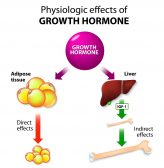Definition
noun, plural: testosterones
A steroid hormone with a chemical formula of C19H28O2, and is regarded as the primary male sex hormone as it is involved in the development of male sex organs and secondary male characteristics, although females also produce it but only in small amounts
Supplement
Androgen is one of the major classes of sex steroids (or sex hormones) of vertebrates, including humans. Androgens include androstenediol (A5), androstenedione (A4), dehydroepiandrosterone (DHEA), dihydrotestosterone (DHT), androsterone, and testosterone.
Testosterone is a steroid hormone that has a chemical formula of C19H28O2. It is the primary male sex hormone. In males, it is produced and secreted mainly by the Leydig cells of the testes. A small percentage of testosterone is produced by the adrenal glands. In females, testosterone is produced (although in relatively very small quantities) in the adrenal glands and thecal cells of the ovaries. During pregnancy, it is also synthesized in the placenta.
Testosterone is biosynthesized from cholesterol by the process steroidogenesis, where the cholesterol undergoes series of enzymatic processes to yield testosterone. When testosterone levels are low, the hypothalamus releases gonadotropin-releasing hormone that stimulates the pituitary gland to release luteinizing hormone (LH) and follicle-stimulating hormone (FSH). In males, LH and FSH stimulate the testes to produce testosterone. The testosterone is released into the bloodstream to reach target tissues. In the blood, it is bound to sex hormone-binding globulin (SHBG). The metabolism of testosterone occurs in the liver as well as in extrahepatic tissues. Testosterone metabolism occurs via the hepatic 17-ketosteroid pathway, the cytochrome P450-mediated testosterone metabolism, etc. Two important metabolites from testosterone metabolism are 5α-DHT and estradiol. 5α-DHT, for instance, is a stronger agonist of androgen receptors than testosterone.
The activation of testosterone occurs when it releases the SHBG and then binds to the androgen receptor on the nucleus of the target cell. The binding causes structural changes in the receptor that allows the testosterone to move inside the nucleus of the cell so that it could bind to specific nucleotide sequences of the DNA of the chromosome. This leads to the transcription of certain genes producing androgen effects, e.g. stimulation of the development of male sex organs (e.g. testes and prostate) and of secondary sexual characteristics (e.g. increased muscle and bone mass and body hair growth).
Testosterone is also involved in certain neurosteroid activities.
Deficiency of testosterone in males is associated with bone loss and frailty. Thus, testosterone is also produced synthetically so that it can be used as a medication for such conditions. Testosterone is also used in breast cancer treatments.
IUPAC name:
- 17β-Hydroxyandrost-4-en-3-one
- (8R,9S,10R,13S,14S,17S)-17-Hydroxy-10,13-dimethyl-1,2,6,7,8,9,11,12,14,15,16,17-dodecahydrocyclopentaaphenanthren-3-one
Chemical formula:
Synonym(s):
- Androst-4-en-17β-ol-3-one
See also:
Related terms:
- Testosterone 5-alpha-reductase
- Epitestosterone






